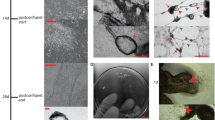Abstract
Human mammary epithelial cells from reduction mammoplasties were serially propagated in vitro from single cells and/or cell clusters using the NIH 3T3 cell feeder layer technique. In seven passages 46 cell population doublings, corrected for plating efficiency were achieved. The plating efficiency of epithelial cells in the primary culture was 0.2%. During subsequent passages it rose to 10–12% and decreased sharply towards the end of the culture life. In the third and fourth passages temporal prevalence of luminal cells was observed. The critical conditions for prevalence of the 1uminal phenotype were found to be the initial dissociation and optimum seeding density during subculturing. In primary cultures, after optimum dissociation of 0.15 cm3 mammary tissue with 0.05% collagenase A (Boehringher‐Mannheim) in Eagle's MEM for 16 h at 37 °C, the yield on day 13 was 20 large colonies of 8–10 mm diameter. About 30% of the epithelial cells, which stained positively for the luminal cell marker cytokeratin 19, occupied colony centres. The remaining 70% were actin positive myoepithelial cells at the periphery. In subsequent passages, when using the optimum seeding density of 2×105 cells per 60 mm culture dish, the proportion of luminal cells gradually increased to 90% on day 35 in the fourth passage. A sudden rise in the proportion of rapidly growing myoepithelial cells to 65% was observed in the fifth passage. In the sixth and seventh passage small colonies were formed, most of which contained at least one keratin‐19‐positive (luminal) cell. Cells of human breast carcinomas are considered to be of luminal origin. Therefore, the described approach can be useful in studies of cell and molecular biology of mammary carcinomas.
Similar content being viewed by others
References
Hammond SL, Ham RG, Stampfer MR: Serum-free growth of human mammary epithelial cells: Rapid clonal growth in defined medium and extended serial passage with pituitary extract. Proc Natl Acad Sci USA 81: 5435–5439, 1984
O'Hare MJ: Breast cancer. In: Masters JRW (ed.) Human cancer in primary culture, A Handbook, Kluwer Academic Publishers, pp. 271–286
Gusterson GA, Warburton MJ, Mitchell D, Ellison M., Neville AM, Rudland PS: Distribution of myoepithelial cells and basement membrane proteins in the normal breast and in benign and malignant breast diseases. Cancer Res 42: 4763–4770, 1982
Taylor-Papadimitriou J, Stampfer M, Bártek J, Lewis A, Boshell M, Lane EB, Leigh IM: Keratin expression in human mammary epithelial cells cultured from normal and malignant tissue: relation to in vivo phenotypes and influence of medium. J Cell Sci 94: 403–413, 1989
Ethier SP, Mahacek ML, Gullick WJ, Frank TS, Weber, BL: Differential isolation of normal luminal mammary epithelial cells and breast cancer cells from primary and metastatic sites using selective media. Cancer Res 53: 627–635, 1993
Bártek J, Taylor-Papadimitriou J, Miller N, Millis R: Patterns of expression of keratin 19 as detected with monoclonal antibodies in human breast tissues and tumours. Int J Cancer 36: 299–306, 1985
Taylor-Papadimitriou J, Shearer M, Stoker MGP: Growth requirements of human mammary epithelial cells in culture. Int J Cancer 20: 903–908, 1977
Péchoux Ch, Gudjonsson T, Ronnov-Jessen L, Bissell MJ, Petersen OW: Human mammary luminal epithelial cells contain progenitors to myoepithelial cells. Dev Biol 206: 88–99, 1999
Matoušková E, Veselý P, Königová R: Modified method of in vitro cultivation of human keratinocytes suitable for grafting. Folia Biol (Praha) 35: 267–271. 1989
Matoušková E, Vogtová D, Königová R: A recombined skin composed of human keratinocytes cultured on cell-free pig dermis. Burns 19: 118–123, 1993
Matoušková E, Dudorkinová D, Pavlíková L, Povýšil C, Veselý P: Clonal expansion of epithelial cells from primary human breast carcinoma with 3T3 feeder layer technique. Folia Biol (Praha) 44: 67–71, 1998
Rheinwald JG, Green H: Serial cultivation of strains of human epidermal keratinocytes: the formation of keratinizing colonies from the single cells. Cell 6: 331–344, 1975
Fusening NE: Epithelial-mesenchymal interactions regulate keratinocyte growth and differentiation in vitro. In: Leigh IM, Lane EB, Watt FM (eds), The Keratinocyte Handbook, Cambridge University Press, Cambridge, 1994, pp. 71–94
Adams EF, Newton CJ, Tait GH, Braunsberg H, Reed MJ, James VHT: Paracrine influence of human breast stromal fibroblasts on breast epithelial cells. Int J Cancer 42: 119–122, 1988
Emerman JT, Stingl J, Petersen A, Shpall EJ, Eaves CJ: Selective growth of freshly isolated human breast epithelial cells cultured at low concentrations in the presence or absence of bone marrow cells. Breast Cancer Res Treat 41: 147–159, 1996
Smith HS, Lan S, Ceriani R, Hackett AJ, StampferMR: Clonal proliferation of cultured nonmalignant and malignant human breast epithelia. Cancer Res 41: 4637–4643, 1981
Bártek J, Durban EM, Hallowes RC, Taylor-Papadimitriou J: A subclass of luminal epithelial cells in the human mammary gland defined by antibodies to cytokeratins. J Cell Sci 75: 17–33, 1985
Lee SK, Hwang JO, Chi JG, Yamada K, Mori M: Prenatal development of myoepithelial cell of human submandibular gland observed by immunohistochemistry of smooth muscle actin and rhodamine-phalloidin fluorescence. Pathol Res Pract 189: 332-341, 1993
Author information
Authors and Affiliations
Rights and permissions
About this article
Cite this article
Matoušková, E., Dudorkinová, D., Krásná, L. et al. Temporal in vitro expansion of the luminal lineage of human mammary epithelial cells achieved with the 3T3 feeder layer technique. Breast Cancer Res Treat 60, 241–249 (2000). https://doi.org/10.1023/A:1006409605067
Issue Date:
DOI: https://doi.org/10.1023/A:1006409605067




